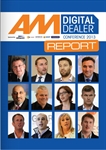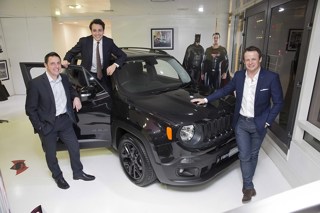All franchised dealers ought to by now be fully aware of the importance of the internet to their business. Yet the digital marketplace develops at a rapid pace, which means no motor retailer can afford to become complacent.
 |
|
The AM Digital Dealer conference 2013, sponsored by Deltapoint, Citnow, GForces, Manheim Retail Services and Marketing Delivery, examined how the digital arena now plays as important a role in customer care and reputation management as it does in marketing. The national event, held at the Heritage Motor Centre in Gaydon, Warwickshire, attracted senior directors and managers from franchised dealerships, groups and manufacturers.
This report of the conference is available as a downloadable electronic magazine at Digital Dealer Conference 2013: Report
Meanwhile, here are key excerpts from the conference presentations and
workshops:
Social Media Strategies: LinkedIn
NEED TO KNOW: ♦ Set objectives before diving into social media
♦ Use LinkedIn for more than just recruitment
 Philip Calvert, LinkedIn expert and author
Philip Calvert, LinkedIn expert and author
Dealers must properly consider the objectives of their business and develop a social media strategy that suits, before they jump onto the various platforms, advised Philip Calvert.
People tend to do the reverse, he said, adding that many of the people on LinkedIn, the business/employment-focused social site, don’t really know why they are there.
With a proper strategy in place, LinkedIn may become a platform for networking to develop business relationships with suppliers and partners, as well as to find new staff, its original purpose. It has 220 million members, 1m groups and reported 5.3bn searches in 2012. Users can set up company pages as well as individual profiles.
“LinkedIn is now a real professionals’ tool, not just something for jobs,” added Calvert. His top tips included selecting the five most relevant keywords for its search engine, monitoring your profile and thanking anyone who views it, listing interests so you’re visible to people with something in common, and making new contacts via the ‘similar’ button.
Calvert also advised businesses not to see the internet as a threat, saying that although people do their own research, many still require an expert view. Dealers can also use it to find out more about existing and prospective customers, he said.
The automotive consumer, how well do you know him?
NEED TO KNOW: ♦ 87% of buyers research car purchase online
♦ 50% of car searches are on mobile or tablet

 Hugh Dickerson, Google senior industry head of automotive, and Al Mottram, Google industry manager
Hugh Dickerson, Google senior industry head of automotive, and Al Mottram, Google industry manager
Representatives from Google shared their latest research into the automotive sector with conference delegates.
The results were based on analysing customers researching their next car or servicing purchase online.
Hugh Dickerson, Google senior industry head of automotive said: “There are three key areas which were identified in the research. Consumers are connected and empowered, savvy and busy and have high expectations.
“How well is your business answering the needs of your consumer? Is your business reacting to how things are changing?”
Key statistics
♦ 87% of buyers use the internet to research their next car purchase.
♦ 50% first learn about a dealer online.
♦ 50% of car purchase searches are carried out on a mobile or tablet device.
♦ 20% of buyers use their mobiles to carry out on-the-spot research at the dealership.
♦ 93% of shoppers mention online searches and services to the salesman at the dealership.
♦ Customers use up to 18.2 online sources for research before buying (reviews, social media, websites, etc.).
♦ 63% of buyers will search multiple makes and models in one session.
♦ 75% of buyers will use online video to help them choose their next car.
♦ Customers take an average of eight days of online research time for their aftersales purchase.
♦ 76% prefer to book their service online.
♦ 47% of consumers said they didn’t get a response they were looking for from dealers to their online request. The responses were neither quick enough nor complete enough.
♦ 52% of customers said vehicle manufacturers didn’t provide the response they were looking for.
♦ 66% of customers will go to a different dealer if they don’t get the response they were looking for first time.
♦ 30% of customers will go online to complain, share their experience with peers or post a review.
♦ Digital and mobile accounts for 44% of how media is now digested by UK consumers in comparison with a 4.4% share from traditional print media.
NEED TO KNOW: ♦ Follow and respond to your customers
♦ Use Twitter’s search engine to find them
 Mark Shaw, Twitter consultant and author
Mark Shaw, Twitter consultant and author
Twitter is a two-way engagement channel not a broadcast channel, Mark Shaw told dealers. It should be used to humanise your brand, to show you’re interesting and helpful and to turn people into advocates for your business.
A key aspect is to listen to people tweeting about you and to reply. It’s a customer care service. Consumers want to be heard and will be impressed if you respond. Dealers should also follow customers on Twitter and learn more about them and their interests.
“Send them something they love for Christmas and they will be your advocate for life,” he added.
Shaw also advised dealers to use Twitter’s search engine to find people looking for what they’re selling. Search for keywords including your brand name and your competitors’.
Shaw said success on Twitter is not an increase in followers – it’s an increase in traffic to your website or sign-ups for your newsletter.
Upping the Digital Game – Dealer Case Study
NEED TO KNOW: ♦ Consider deals websites to quickly fill capacity
♦ Dealership teams answer queries on mobiles
 Lisa Ford, operations director Mana Premiere Automobiles
Lisa Ford, operations director Mana Premiere Automobiles
To help establish its new Infiniti brand in the UK, Mana Premiere invested in its digital strategy to reach as many customers as possible from a standing start.
Creating an amazing digital experience was the best way to reach new customers and convince prospects to try Infiniti at its dealerships in Birmingham, Glasgow, Leeds and Stockport. Mana won Best Dealer Website at this year’s AM Awards.
Lisa Ford, Mana Premiere operations director, said: “We started our digital journey in the second quarter of 2011 and our database was essentially a blank piece of paper. We really needed to find a way of getting on customers’ shopping lists and so we invested in digital, taking inspiration from premium retail digital shopping websites like John Lewis and Net-A-Porter.”
Mana posted offers on Groupon to help utilise excess servicing capacity at the group’s dealerships. Mana’s Birmingham dealership sold 80 service slots in 24 hours and the Glasgow dealership sold 100 in less than 24 hours. Ford said: “Groupon has worked for us. It’s great for targeting people that are looking for a deal on a budget. As a retailer you have to negotiate how much turnover you hand over to Groupon, rather than profit. It works if you’re trying to quickly fill capacity.”
The group uses LiveChat to keep in touch with customers in and out of work hours, but doesn’t outsource it, instead using a rota of dealership teams to answer enquiries on mobiles up to 10pm.
Ford said: “We don’t use call centres based thousands of miles away because we want the people with the best knowledge and understanding of the business to respond to customers.”
The changing digital landscape
NEED TO KNOW: ♦ A rise in traffic will not always increase sales
♦ Analyse audiences to achieve better results
 James Murray, digital insight manager, Experian Marketing Services
James Murray, digital insight manager, Experian Marketing Services
Digging into layers of consumer data can help dealers and manufacturers more accurately target the right people with their offers, said James Murray.
The results can surprise. He asked delegates what they thought was the most searched-for gift last Christmas. Most suggested a tablet computer or similar gadget. But the answer was a onesie. Murray described trends relating to new car buyers, such as being 19% more likely to visit the BMW website and 13% less likely to visit the French brands. Ford is the most searched-for brand, but doesn’t have the most visited website, perhaps because searchers go to its dealer sites, he said.
He highlighted a 2011 campaign by Volvo on publishing websites, which generated a 22% increase in traffic to its website. But Experian’s Mosaic demographic analysis showed the new audience, largely low-income, single-car households, was wrong for Volvo.
His message was that identifying and isolating audiences will deliver better results. “You need to think beyond what you’re selling. Truly understand your customers and you can engage them with something truly relevant.”
How to sell cars digitally workshop
NEED TO KNOW: ♦ Web search data can inform pricing decisions
♦ Stock profiling system ‘offers greater ROI’

 Alex Lowe, sales and marketing director, and Tim Marriott, senior product manager, Deltapoint
Alex Lowe, sales and marketing director, and Tim Marriott, senior product manager, Deltapoint
Used car dealers can use a new set of metrics to remove the guesswork from stock-buying and pricing decisions, delegates at the AM Digital Dealer Conference were told.
Alex Lowe, Deltapoint sales and marketing director and Tim Marriott, senior product manager, outlined their stock profiling system, which uses data from Auto Trader’s website searches to improve margins.
“We have compared the performance of two comparable dealers, with the same amount and type of stock and marketing spend and the dealer that uses the new metrics, allowing them to choose stock that is in high demand and price it intelligently, has seen a huge difference in return on investment,” said Lowe. The new metrics were:
♦ Desirability: a one- to five-star rating, sourced from Auto Trader searches, ranks a car based on four attributes a sales manager looks for when buying stock: potential to make a good margin, historic speed of sale, current consumer demand, competition in the market.
♦ Burn rate: given in days and based on a car’s supply and demand level based on live market supply and sales data. The lower the number, the higher the demand and vice versa.
♦ Price position: a % value that tells you how close a dealer’s chosen retail price is to the live market value of a car based on the competition. If the figure is 100%, it shows a car’s price is the average for CAP-coded vehicles in the market. The most common price position online is 98%.
A look at the prices of 320,000 cars advertised on autotrader.co.uk on one day, Lowe said, showed a third were not in the right position.
Dominating the search workshop
NEED TO KNOW: ♦ Getting paid-for and natural search results on the same page can boost click-throughs 32%
 Tim Smith, commercial director, GForces
Tim Smith, commercial director, GForces
Dealers should look to dominate search results on Google to maximise the amount of leads feeding through to their website.
Tim Smith, GForces commercial director, said: “Online generates 70% of all leads and from that, 70% is generated through search engines.
“Google dominates UK search with 91% of the market. As a result, you have to be at the top of those search results to reach customers.” Google is constantly updating the way its search engine works with the intent of making the search function react in a more human way. This means getting rid of any content trying to trick how Google indexes pages.
Smith said that if dealers can invest in their search engine optimisation (SEO) they can “dominate the search” by making sure their website is displayed in the natural search results as well as the pay-per-click (PPC) section at the top of the page.
Natural or organic search results on Google are the results that appear because of their relevance to the search terms, as opposed to being paid-for advertisements.
According to Smith, if paid and natural search results are displayed on the same page together, it can boost click-throughs by 32%.
Smith said: “Dealers need to be dominating the search in this way, with videos, customer reviews and images, which will all be displayed in search results if Google believes the content to be relevant to the search.
“This means that potentially a competitor’s results will be pushed further down the search results page or even off onto the second page, making them irrelevant.”
CRM in the digital world workshop
NEED TO KNOW: ♦ Consumers prefer contact by email
♦ Automation gives many contact opportunities
Jeremy Evans, managing director, Marketing Delivery
 In a workshop session, Jeremy Evans explained to delegates how automated processes can ensure the dealership has multiple opportunities to keep in touch with customers. Marketing Delivery’s research has shown that consumers prefer contact by email and they actually like to have contact from brands with information and relevant advice.
In a workshop session, Jeremy Evans explained to delegates how automated processes can ensure the dealership has multiple opportunities to keep in touch with customers. Marketing Delivery’s research has shown that consumers prefer contact by email and they actually like to have contact from brands with information and relevant advice.
“In this industry there’s a real danger that we concentrate on the car. CRM is about the customer, not the car,” he said.
Evans demonstrated some of the e-CRM work done by Marketing Delivery with its dealer clients, such as Swansway Group and Cambria Automobiles. These included contacts such as regular service reminders, seasonal health checks and messages of thanks from a senior manager to prospective customers for their enquiry, whether they bought a car or not. Each can have multiple calls to action, from a call-back request to website click-throughs or a pre-populated booking form.
Such resources give a dealer back-up in case a staff member hasn’t done their job properly or a customer has missed a service due to holiday. They can also remind customers of the benefits of using a dealership, such as courtesy cars or a pick-up and collection service.
The role of video for the forward-thinking dealer
NEED TO KNOW: ♦ Video can help build trust and transparency
♦ Dealers should experiment using smartphones to record footage
Alistair Horsburgh, Citnow director
 Three-quarters of prospective car buyers will use video during their research and dealers can use the medium to tackle no-shows for appointments and increase trust.
Three-quarters of prospective car buyers will use video during their research and dealers can use the medium to tackle no-shows for appointments and increase trust.
Dealers using Citnow video technology can create personalised videos for each customer ahead of their appointment.
Alistair Horsburgh, Citnow director, said: “Creating a video and delivering something a customer might not be expecting in the form of a personal video will encourage customers to ring back. It hands over some of the power to customers too, so when they’re arriving at the dealership they will recognise the sales executive that introduced themselves through video.”
Horsburgh encouraged dealers to try using video to film walkarounds of used and new car stock.
Renault Retail Group was used as an example of how they can be used to build trust with customers. If a customer isn’t quite sure about a certain model, sales executives can film a quick walkaround and email a link to the video with no catches.
Dealers can use their own smartphones to take footage and upload it to video sites such as YouTube or through platforms such as Citnow.
Using video in the service department can also increase transparency and validate the need for required work, visually demonstrating to customers the kind of wear on tyres or brake pads to help convince them they need to take action.
Web Strategy Optimisation workshop
NEED TO KNOW: ♦ Google changes lowered click-through rates
♦ Consumers want 360° tours, videos, blogs
 Luke Carter, head of search, Manheim Retail Services
Luke Carter, head of search, Manheim Retail Services
Luke Carter gave delegates some operational tips to ensure their businesses performed more strongly in web search. Many websites have seen click-through rates decline since Google changed its algorithms last year because the search company now puts greater emphasis on the user experience, not the keywords and links it contains.
Consumers want to see 360-degree tours, reviews, answers to frequently asked questions, videos and blogs, and these will get a website ranked higher by Google than another that doesn’t have them, Carter said. Equally, generic content will let a website down.“It’s about real world experience, what is good for the user,” he added.
Digital qualification and follow-up is key
NEED TO KNOW: ♦ Customer information can be gathered online to inform marketing strategies ♦ Data should be segmented and advertising can be made more personal
 Hugh Dickerson, Google senior industry head of automotive
Hugh Dickerson, Google senior industry head of automotive
Dealers should make sure their websites and adverts are targeted at the right customers and can adapt to information gathered online.
Dickerson said: “Dealers always say qualification is key, but what’s happening in the showroom is not happening online in the majority of cases.
“If a customer has already visited a dealer website before, they are treated like a stranger when they return. Dealers can use tracking techniques to personalise adverts and content for customers to be more relevant for customers visiting their websites and viewing adverts.”
It is possible to track what Google calls “audience signals” and find out who customers are and what they like. Dickerson believes dealers can build a clearer picture of customers using audience signals to make sure ads are not being pushed to people that won’t be interested in them.
Adverts can be targeted by tracking cookies and keywords customers are using to find what they’re looking for online.
Dealers can also use targeted video adverts which intelligently track whether a customer has already viewed the video in a previous internet session.
Social media strategies: Facebook
NEED TO KNOW: ♦ Dealers must match users’ active times
♦ A strong community will defend your brand
 Maeve O’Sullivan, content director, Headstream
Maeve O’Sullivan, content director, Headstream
Dealers should look at Facebook as another way to keep in contact with customers and create a community of advocates for their business.
Maeve O’Sullivan, Headstream content director, said: “Dealers need to know when to step in and interact, when to share information and when to stay quiet. Listening to your audience is almost as important as posting content.”
O’Sullivan also believes that a strong social community will help to self-police dealership pages should there be any unreasonable comments by Facebook users looking to be abusive for fun (trolling).
She said: “If someone has posted something abusive, your community will shout down that person and defend you.”
Dealers should make sure the content they are posting on Facebook is balanced between being entertaining and informative.
All posts from customers on Facebook should receive a response and the timing of that response depends on the comment. If it’s a general comment, a couple of hours is fine but if it’s a potential lead or problem, a response should be within minutes if possible.
O’Sullivan said: “Social is not a 9-5 thing, it is 24/7. Most people are on Facebook in the evening and weekend. Dealer activity should reflect that.”
Appliances Online, the online white goods retailer, was marked out as the top performer for social in Headstream’s Social Brands 100 2013 list. Its Facebook page, www.facebook.com/AOLetsGo, carries photos of the staff and they respond to all interactions using their own names.
AO’s delivery drivers, who have the company’s only face-to-face contact with customers, get a printed manual each month that includes the best and worst feedback from the Facebook page. O’Sullivan said AO was a great example of how social was being used throughout a business, rather than being reserved as the responsibility of one person in the office.
Key statistics
♦ 75% of female car buyers and 54% of male car buyers use Facebook.
♦ 69% of prospective car buyers said a friend’s favourable Facebook post would positively affect their opinion of a dealership.

















Login to comment
Comments
No comments have been made yet.